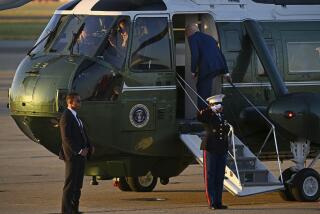AEROSPACE AND DEFENSE : Arms Firms Accused of Testing-Law Violations : * Defense: To prevent conflict of interest, contractors that develop weapons are not supposed to test them.
- Share via
WASHINGTON — Pentagon officials and defense contractors have frequently violated a 1989 conflict-of-interest law involving the development and testing of major weapons systems, the Pentagon’s inspector general said in a report released Friday.
The same contractors who helped test weapons, such as the F-14 fighter plane and the Stinger missile, also participated in their development, creating an opportunity for problems to be covered up, the 119-page report concluded.
Field tests of weapons lacked the “required impartiality and independence,” and test assessments “may have been biased,” the report said. “Systems may have been produced and deployed with unknown performance limitations.”
In addition, Inspector General Susan G. Crawford found that the military services’ testing offices relied too much on outside contractors and could save more than $26 million over four years by performing more work in-house.
Rep. Barbara Boxer (D-Greenbrae), who sponsored the 1989 ban against testing of weapons by their developers, requested the Pentagon audit after an anonymous caller told an aide of possible violations.
In releasing the report, Boxer called the infractions “disappointing and troubling” and, in a letter to Defense Secretary Dick Cheney, urged that pressure be put on testing offices to follow the law. She said she will try to tighten the statute in next year’s defense bill. There are now no penalties for violations.
Boxer is a member of the House Armed Services Committee and co-chair of the Congressional Military Reform Caucus. She also is a candidate for the U.S. Senate seat being vacated by Democrat Alan Cranston.
The inspector general’s office reviewed four weapons from each of the services, including the F-14 Tomcat, the AMRAAM missile, the Milstar communications satellite and the Stinger missile.
Two contractors, Colsa Inc. and BDM International Inc., participated in both the development and the operational tests of the Army’s Pedestal Mounted Stinger system.
Colsa was awarded a development contract in November, 1987--two years before the conflict-of-interest ban took effect--but was working on it long afterward. By September, 1990, the firm had earned about $9 million, the audit found.
Meanwhile, Colsa was awarded two testing contracts in 1987 and 1988. By September, 1990, the firm had received about $12.5 million.
The Navy paid Veda Inc. about $2.5 million from May, 1988, to June, 1990, to help with development of the F-14. Veda also was a major subcontractor to Webster Engineering Co. on tests of the plane. Webster was required to notify the Navy if any of its subcontractors were involved in the development phase. That would have barred Veda’s involvement.
“However, Webster Engineering sent the (Navy) contracting officer a letter stating that neither he nor Veda felt that there was any conflict of interest relevant to the contract,” the inspector general’s report said.
Three contractors--Booz-Allen & Hamilton Inc., BDM International Inc. and Science Applications International Corp.--all helped with the development and field testing of the Air Force’s Milstar system.
Conflict-of-interest clauses in the three contracts “should have precluded these contractors from supporting the Air Force Operational Test Agency,” the report said.
The report recommended not only strengthened conflict-of-interest rules at the Pentagon but also new legislation allowing waivers to be granted in some cases.
In formal comments, the Army and Air Force endorsed the waiver proposal. The Army said development contractors often have the expertise for field tests that no other firm possesses.
More to Read
Inside the business of entertainment
The Wide Shot brings you news, analysis and insights on everything from streaming wars to production — and what it all means for the future.
You may occasionally receive promotional content from the Los Angeles Times.










